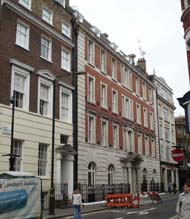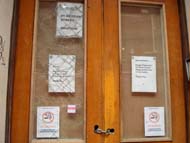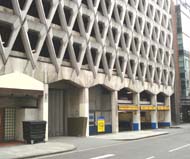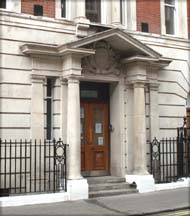West End Hospital
for Neurology and Neurosurgery
for Neurology and Neurosurgery
91 Dean Street, Soho, W1
Medical dates:
Medical character:
Specialist
The
West End Hospital for Diseases of the Nervous System, Paralysis and
Epilepsy opened at 73 Welbeck Street in 1878. Dr. Herbert
Tibbits, its founder, was one of many who advocated the use of
electricity as a treatment for conditions of the nervous system.
By the 1880s medical electrical departments had even become common in
general hospitals. Electrical engineers invented various ways of
generating electricity of various kinds -- electrostatic, DC, low and
high frequency AC - and by the end of the 19th century many devices
were available. Pulvermacher chains were popular and, later, Cornelius Bennett Harness' electropathic belts and corsets.
The Hospital was also a pioneer in the psychiatric field. Milder forms of psychiatric illness were treated there, but its main function was for the care of neurological patients. It was during the early 20th century that the terms 'neurosis', 'neurasthenia', 'nervous debility' and 'nervous breakdown' were coined, and confusion as to their exact meaning remains to some extent today. At the time it was thought that these conditions were due to a physical malfunction of the brain, thereby they fell within the domain of neurology. A close relationship therefore existed between neurology and psychiatry.
In 1914, during WW1, the Hospital was affiliated with the Third London Hospital and reserved 20 beds for sick and wounded servicemen. (By 1917 this number had been increased to 30 beds.)
In 1915 the Hospital changed its name to the West End Hospital for Nervous Diseases. In 1918 a speech therapy clinic was established, which concentrated on treatment for stammering (the first school of speech therapy was later founded at the Hospital in 1929).
In 1919 the building at 73 Welbeck Street became the Out-Patients Department while the in-patients moved to the vacated St Katharine's Lodge - the former Master's House of St Katharine's Hospital in Regent's Park. The Lodge had been refurbished and contained 75 beds with some single-bed wards, a modern operating theatre, an X-ray department and electrotherapy treatment rooms. Additions included a Pathology Department, a Post-Mortem room and a mortuary chapel, with statues of guardian angels on either side of the altar. The Hospital was also equipped for 'sun treatment'.
During the 1920s the Hospital opened a Child Guidance Clinic, which had three psychiatrists and three to four lay psychotherapists on its staff.
In 1932 a psychiatrist was also appointed to care for the in-patients at St. Katherine's Lodge. By 1938 the Hospital had 96 beds and a children's ward with 25 cots.
During WW2 the Hospital provided accommodation for the Institute for the Study and Treatment of Delinquency in its Welbeck Street building. Later in the war the Welbeck Street building was severely damaged by bombing and the Regent's Park building was hit by a V1 flying bomb; in-patients were transferred to temporary wards at St Charles Hospital, where 60 beds were made available.
In 1947 a psychologist was appointed to the staff as an Honorary Consultant. In the same year a Department of Speech Disorders was established, with a psychiatrist as a permanent member of staff (this would be taken over in 1974 by the Speech Therapy Training School in Great Portland Street and Moor House School of Speech Disorders in Oxted, Surrey).
In 1948 the Hospital joined the NHS under the administrative control of the North West Metropolitan Regional Board.
In 1951 the psychiatric department of the Hospital moved to Cosway Street, to become the St Marylebone Hospital.
It finally closed in 1972.
Present status (June 2008)
The Dean Street building is now used as a hostel, with the entrance at the rear in Great Chapel Street
The Hospital was also a pioneer in the psychiatric field. Milder forms of psychiatric illness were treated there, but its main function was for the care of neurological patients. It was during the early 20th century that the terms 'neurosis', 'neurasthenia', 'nervous debility' and 'nervous breakdown' were coined, and confusion as to their exact meaning remains to some extent today. At the time it was thought that these conditions were due to a physical malfunction of the brain, thereby they fell within the domain of neurology. A close relationship therefore existed between neurology and psychiatry.
In 1914, during WW1, the Hospital was affiliated with the Third London Hospital and reserved 20 beds for sick and wounded servicemen. (By 1917 this number had been increased to 30 beds.)
In 1915 the Hospital changed its name to the West End Hospital for Nervous Diseases. In 1918 a speech therapy clinic was established, which concentrated on treatment for stammering (the first school of speech therapy was later founded at the Hospital in 1929).
In 1919 the building at 73 Welbeck Street became the Out-Patients Department while the in-patients moved to the vacated St Katharine's Lodge - the former Master's House of St Katharine's Hospital in Regent's Park. The Lodge had been refurbished and contained 75 beds with some single-bed wards, a modern operating theatre, an X-ray department and electrotherapy treatment rooms. Additions included a Pathology Department, a Post-Mortem room and a mortuary chapel, with statues of guardian angels on either side of the altar. The Hospital was also equipped for 'sun treatment'.
During the 1920s the Hospital opened a Child Guidance Clinic, which had three psychiatrists and three to four lay psychotherapists on its staff.
In 1932 a psychiatrist was also appointed to care for the in-patients at St. Katherine's Lodge. By 1938 the Hospital had 96 beds and a children's ward with 25 cots.
During WW2 the Hospital provided accommodation for the Institute for the Study and Treatment of Delinquency in its Welbeck Street building. Later in the war the Welbeck Street building was severely damaged by bombing and the Regent's Park building was hit by a V1 flying bomb; in-patients were transferred to temporary wards at St Charles Hospital, where 60 beds were made available.
In 1947 a psychologist was appointed to the staff as an Honorary Consultant. In the same year a Department of Speech Disorders was established, with a psychiatrist as a permanent member of staff (this would be taken over in 1974 by the Speech Therapy Training School in Great Portland Street and Moor House School of Speech Disorders in Oxted, Surrey).
In 1948 the Hospital joined the NHS under the administrative control of the North West Metropolitan Regional Board.
In 1951 the psychiatric department of the Hospital moved to Cosway Street, to become the St Marylebone Hospital.
It finally closed in 1972.
Present status (June 2008)
The Dean Street building is now used as a hostel, with the entrance at the rear in Great Chapel Street




The building at 91 Dean Street. Notices on the front door advise callers to use the entrance at the back of the building
The site of 73 Welbeck Street has become the entrance to a multistorey car park
The site of 73 Welbeck Street has become the entrance to a multistorey car park
(Author unstated) 1914 Summary of the work since the outbreak of war to date. London, British Red Cross Society.
(Author unstated) 1917 List of the various hospitals treating military cases in the United Kingdom. London, H.M.S.O.
Bennet EA (date unknown) West End Hospital for Nervous Diseases. (Chapter 38 of an unpublished, undated manuscript located at the Wellcome Library).
Fishlock D 2001 Doctor volts (electrotherapy). IEE Review 47: 23-28.
Morus IR 2006 Bodily disciplines and disciplined bodies: instruments, skills and Victorian electrotherapeutic. Social History of Medicine 19: 241-259; doi:10.1093/shm/hk1037
Winner HI 1964 West End Hospital for Neurology and Neurosurgery, Dean Street, London. Nursing Times 60: 1431-34.
http://rcnarchive.org.uk
www.1914-1918.net/hospitals_uk.htm
www.british-history.ac.uk
www.ucl.ac.uk
Return to home page